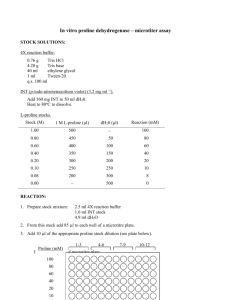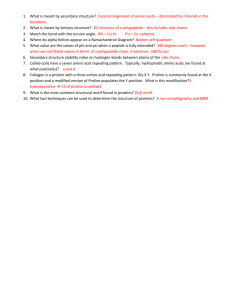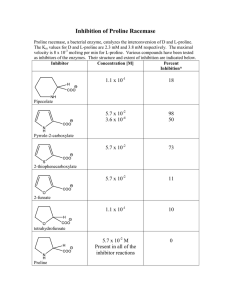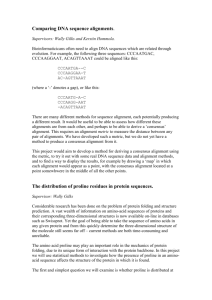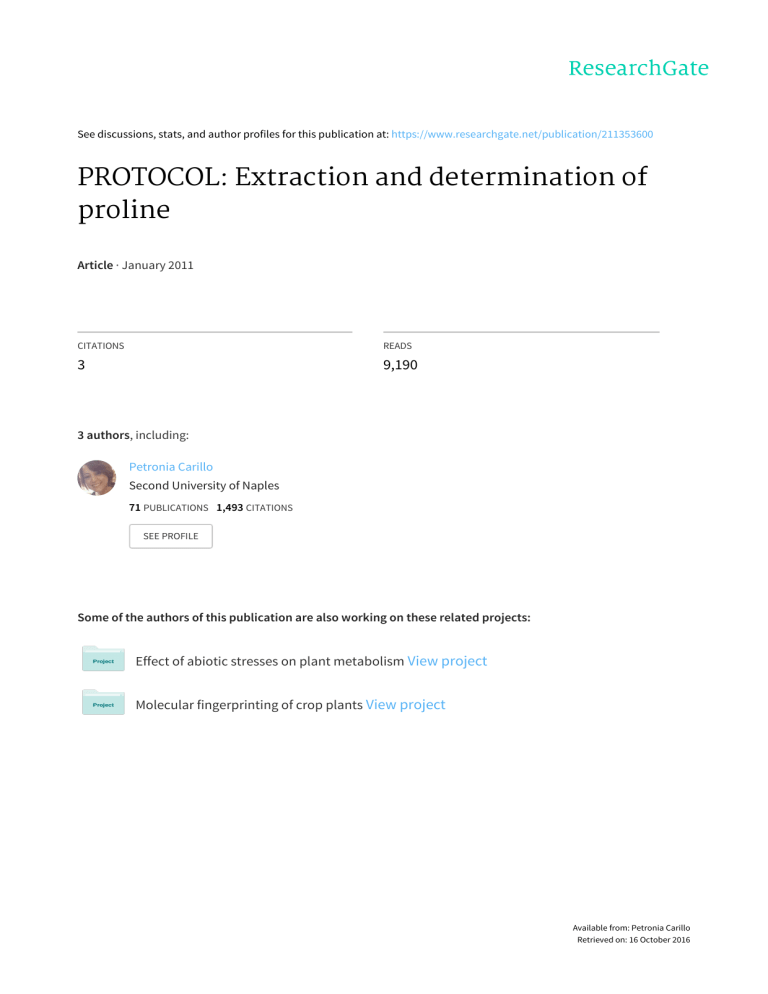
See discussions, stats, and author profiles for this publication at: https://www.researchgate.net/publication/211353600 PROTOCOL: Extraction and determination of proline Article · January 2011 CITATIONS READS 3 9,190 3 authors, including: Petronia Carillo Second University of Naples 71 PUBLICATIONS 1,493 CITATIONS SEE PROFILE Some of the authors of this publication are also working on these related projects: Effect of abiotic stresses on plant metabolism View project Molecular fingerprinting of crop plants View project Available from: Petronia Carillo Retrieved on: 16 October 2016 PROTOCOL: Extraction and determination of proline Initiating Author Name: Petronia Carillo & Yves Gibon Author Affiliations: Petronia Carillo - Department of Life Science, II University of Naples, via Vivaldi 43, 81100, Caserta, Italy Yves Gibon - INRA, UMR 619, Biologie du Fruit, 33883 Villenave d’Ornon, France Overview This protocol describes how to assay the amino acid proline with a ninhydrin-based simple, fast and harmless method using a microplate reader or a cuvette spectrophotometer. Background Overproduction of proline is a widespread response observed in plants experiencing various stresses, in particular osmotic stresses. The determination of this amino acid is therefore very useful to assess the physiological status and more generally to understand stress tolerance in plants. Here we describe a simple, fast and relatively harmless ninhydrin-based method, which is suitable for the high throughput determination of free proline content using a microplate reader. Ninhydrin (2,2dihydroxyindane-1,3-dione, CAS number 485-47-2) is extensively used to assay amino acids. At neutral pH, it destroys each primary α-amino acid and also reacts with the released NH3 to form a deep purple chromogen referred to as Ruhemann's Purple, which has a maximum absorption at about 570 nm. At low pH, Ruthermann’s purple is also yielded, but it quickly looses an amine residue, which results into colourless derivatives. The reaction with proline and other imino acids such as hydroxyproline or pipecolic acid yields a yellow-orange product at neutral pH, as the cyclised N-group is not released. At low pH, the chromogen is red, with a peak of absorbance at 520 nm. It is important to note that ornithine and to a lesser extent lysine also yield a red chromogen at low pH, which result from one ninhydrin molecule binding two amino acids. Nevertheless, in plants under stress, levels of these amino acids are usually much lower than proline levels. In order to decrease background noise (e.g., high levels of anthocyanins that may interfere with the quantification), the chromogen is classically extracted using harmful solvents such as benzene (Troll and Lindsey, 1955) or toluene (Bates et al., 1973). We have removed this step to make the assay safer and easier, considering that interferences due to other compounds are usually low, especially in plants under osmotic stress. CAUTION: Ninhydrin is irritant to skin and respiratory system, thus requiring adequate precautions, in particular the wearing of gloves. This colorimetric assay is quantitative and provides reliable data about proline content. The sensitivity is of about 1 nmole and the linearity is in a range of 1-100 nmoles. Materials/Equipment Proline Ninhydrin Glacial acetic acid Ethanol (98%) Screw-cap tubes (1.5 ml tubes or 96-microplate tubes) Block heater or water bath Centrifuge (for microtubes or for microplates) Polystyrene spectrophotometer 1.5 ml-cuvette or polystyrene flat-bottom 96-well microplates (flat bottom) Cuvette spectrophotometer or microplate reader equipped with a monochromator or a 520 nm filter Units, terms, definitions Proline content - μmol g-1 FW Procedure Plant material and extraction Proline is very soluble and can be readily extracted by heating explants or aliquots of ground plant material for 20 min in pure ethanol as well as in water. Proline can also be extracted together with total amino acids, pigments, soluble sugars by heating plant material twice with 80% ethanol and once with 50% ethanol as described by Cross et al. (2006), which results into a 70:30 ethanol:water mixture (v/v). Proline and total amino acids may also be extracted using a cold extraction procedure by mixing 20-50 mg fresh weight aliquots with 0.4-1 ml of ethanol:water (40:60 v/v). The resulting mixture is left overnight a 4°C, and then centrifuged at 14000 g (5 min). The cold extraction procedure can be repeated on the pellet and supernatants pooled and used for the analyses. The first extraction, however, already allows a recovery > 93% (Carillo et al. 2008) Proline determination Solutions (store at -20°C): Extract: 20 to 50 times diluted fresh weight (w/v), typically in a 70:30 ethanol:water mixture (v/v) (Hummel et al., 2009). Standards: proline solutions ranging from 0.04 to 1 mM, in the same medium as the one used for the extraction. Reaction mix: ninhydrin 1% (w/v) in acetic acid 60% (v/v), ethanol 20% (v/v). Protect from light. CAUTION For the following steps gloves are highly recommended MICROPLATE READER PROTOCOL: In screw-cap tubes process as following: pipette 100 μl of reaction mix pipette up to 50 μl ethanolic extract or 50 μl of 1-0.4-0.2-0.1-0.04 mM proline standard prepared in 70:30 ethanol:water (v/v) seal the tubes, mix and heat at 95°C (either in block heater or water bath) for 20 min after cooling at room temperature, spin down quickly (1 min, 2500 rpm) transfer e.g. 100 μl of the mixture to a microplate well read at 520 nm (microplate reader) NB: screw-cap tubes in 96-well format enable the use of a pipetting robot and of an automatic capper/decapper. CUVETTE SPECTROPHOTOMETER PROTOCOL: In 1.5 ml screw-cap tubes, pipette as following: 1000 µl of reaction mix pipette up to 500 µl ethanolic extract or 100 µl of 5-2-1-0.5-0.2 mM proline standard completed with up to 400µl of ethanol:water (40:60 v/v) seal the tubes, mix and heat at 95°C in the block heater for 20 min centrifuge (1 min, 10000 rpm) transfer tube contents to a 1.5 ml cuvette read at 520 nm Calculations: As shown in figure 1, the relationship between the amount of proline and the corresponding absorbance is linear in the 1-50 nmol range in the microplate reader (note that linearity may vary according to reader features) and in the 1-100 nmol range in a cuvette spectrophotometer. The following equation is used to calculate the amount of proline in the extracts: Proline in nmol.mg -1 FW or in µmol.g-1 FW = (Absextract – blank)/slope*Volextract/Volaliquot*1/FW Where: Absextract is the absorbance determined with the extract, blank (expressed as absorbance) and slope (expressed as absorbance∙nmol-1) are determined by linear regression, Volextract is the total volume of the extract, Volaliquot is the volume used in the assay, FW (expressed in mg) is the amount of plant material extracted. It is assumed that Absextract is within the linear range. In plant tissues, proline typically ranges from 0.5 (unstressed) to 50 (stressed) µmol.g -1 fresh weight. Calibration curve for proline 3 Absorbance y = 0.055x + 0.078 2 R2 = 0.999 1 y = 0.031x + 0.041 R2 = 0.999 0 0 10 20 30 40 50 Proline (nmoles) Figure 1. Calibration curve obtained with the microplate procedure ( ). Note that with the cuvette procedure ( ) the linear range is approximately the same. Literature references Bates LS, Waldren RP, Teare ID (1973) Rapid determination of free proline for water stress studies. Plant Soil 39: 205-207. Carillo P, Mastrolonardo G, Nacca F, Parisi D, Verlotta A, Fuggi A (2008) Nitrogen metabolism in durum wheat under salinity: accumulation of proline and glycine betaine. Functional Plant Biology 35: 412–426. Cross JM, von Korff M, Altmann T, Bartzetko L, Sulpice R, Gibon Y, Palacios N, Stitt M (2006) Variation of Enzyme Activities and Metabolite Levels in 24 Arabidopsis Accessions Growing in Carbon-Limited Conditions. Plant Physiology 142: 1574-1588. Hummel I, Pantin F, Sulpice R, Piques M, Rolland G, Dauzat M, Christophe A, Pervent M, Bouteillé M, Stitt M, Gibon Y, Muller B. (2010) Arabidopsis plants acclimate to water deficit at low cost through changes of carbon usage: an integrated perspective using growth, metabolite, enzyme, and gene expression analysis. Plant Physiology 154: 357-372. Troll W, Lindsey J. (1955) A photometric method for the determination of proline. Journal of Biological Chemistry 215: 655-660. Health, safety & hazardous waste disposal considerations Ninhydrin is irritant to skin and respiratory system, thus requiring adequate precautions, in particular the wearing of gloves. The original document is available at http://prometheuswiki.publish.csiro.au/tikiindex.php?page=PROTOCOL%3A+Extraction+and+determination+of+proline
